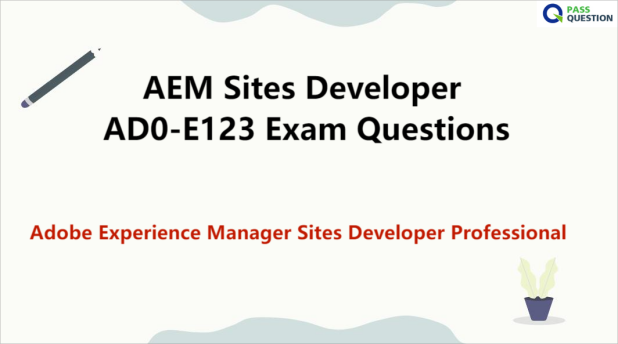AEM Sites Developer AD0-E123 Exam Questions - Adobe Experience Manager Sites Developer Professional
Are you beginning your preparations for the AD0-E123 Adobe Experience Manager Sites Developer Professional exam? PassQuestion offers the latest AEM Sites Developer AD0-E123 Exam Questions that are updated regularly and designed to reflect the actual exam format. By using these AEM Sites Developer AD0-E123 Exam Questions, you can familiarize yourself with the type of questions you'll encounter on the real exam and master the content of the syllabus. It gives you confidence, knowing that you are well-prepared and have covered all areas that the exam will test. When you sit for the real AD0-E123 Adobe Experience Manager Sites Developer Professional exam, you'll be well-equipped to secure the highest possible score.

Exam Details
- Level: Professional (0-12 months’ experience)
- Passing Score: 31/50
- Time: 100 mins
- Delivery: Online proctored (requires camera access)
- Available languages: English
- Cost: $125 (global) / $95 (India)
- Exam ID: AD0-E123
Minimum experience
You should be an application developer and have:
- 0-12 months of experience working with the AEM Platform
- The ability to perform component development
- A basic understanding of the MVC framework, life cycle frameworks and libraries in AEM
Exam Objectives and Scope
Section 1: Configurations (26%)
- Recognize the purpose of AEM dispatcher configurations and caching
- Determine the correct steps to configure multi-site in AEM
- Explain how to create and manage OSGi configurations
- Determine the correct steps to to manage custom OAK indices
- Determine the correct steps to configure OOTB SAML or IMS integration
Section 2: AEM development (40%)
- Determine the correct steps to implement core-based components
- Connect component functionality including the HTL, models, and services
- Given a scenario, determine the correct steps to develop workflows
- Given a scenario, outline the purpose of content fragments or experience fragments
Section 3: Build and deployment (12%)
- Define Maven project structure
- Configure projects from archetypes
Section 4: Environment maintenance (22%)
- Given a scenario, determine the steps required to debug issues in AEM environments
- Explain AEM maintenance releases
- Identify how to configure AEM across topologies
- Determine the steps required around planning and migrating to AEM as a Cloud Service
View Online Adobe Experience Manager Sites Developer Professional AD0-E123 Free Questions
1. Which two methods are used to update the cache? (Choose two.)
A. Content Updates
B. Restart on AEM Author Instance
C. Restart on AEM Publish Instance
D. Auto-invalidation on the Dispatcher
Answer: A D
2. A developer is starting an AEM instance every time in the debug mode by providing JVM parameters in the console. The developer needs to automate this process to avoid adding JVM parameters at every start of an AEM instance.
How would the developer accomplish this goal?
A. By adding JVM parameters to the [runmode]/crx-quickstart/conf/quickstart.properties
B. By setting the OSGi configuration "AEM-start' to true
C. By adding JVM parameters to the start script
Answer: C
3. A developer has modified an existing workflow model in AEM, which defines series of steps to be executed.
When a user starts this workflow, recent changes/warkflow steps are not available in the workflow instance.
What could be the reason for this behavior of the Workflow Model?
A. The workflow model has not been synced in runtime.
B. The user doesn't have the respective permissions.
C. Subsequent steps, which have to be executed after the recent step, produce an error.
Answer: A
4. A developer working in an AEM as a Cloud Service environment will be using Golden Master.
What is being used by this developer?
A. Publishtier
B. Content Repositoty
C. Cloud Manager Git Repository
Answer: C
5. In an AEM as a Cloud Service environment, a client needs a feature to be able to explicitly clear a dispatcher cache of required resources.
Which approach is preferred to create this feature?
A. Enable the explicit cache invalidation feature in cloud manager.
B. Use Replication API along with replication flush agent.
C. Create a serviet, which will make an HTTP request to the dispatcher.
Answer: B
6. Which two options are included in the AEM service pack release notes? (Choose two.)
A. Deprecated features
B. Known issues
C. Next service pack release dale
D. Download link to AEM jar
Answer: AB
7. While configuring a Content Fragment Component, the author has selected ‘Display Mode’ as ‘Single Text Element’. This enables the selection of one multiline text element and enables paragraph control options.
Which two properties will now determine the resulting action? (Choose two.)
A. Paragraph Description
B. Paragraph Heading
C. Paragraph Range
D. Paragraph Scope
Answer: CD
8. Multiple Experience fragments have been created as a part of the ongoing AEM Project. These Experience fragments can be exported to Adobe Target using the "Export to Adobe Target" configuration and by providing Cloud Configuration for Adobe Target.
What is the default format used to complete this export?
A. HTML
B. XML
C. JSON
Answer: A
9. A developer is checking an AEM start script on the server and notices the CQ_JVM_OPTS parameter is set to the following:‘-agentlib:jdwp=transport=dt_socketladdress=8000, server=y,suspend=n” How will this value affect the start of the AEM instance?
A. AEM instance will run in the debug mode
B. AEM instance will temporarily be suspended, and it will not be able to start
C. AEM instance will start in the publish mode
Answer: A
10. A developer has created a transient workflow, but a specific step defeats the purpose of making the workflow transient. The step creates a sling job to proceed further and generates error messages in log files.
Which step must be avoided to eliminate this problem?
A. Container Step
B. Goto Step
C. Process Step
Answer: C
- TOP 50 Exam Questions
-
Exam
All copyrights reserved 2025 PassQuestion NETWORK CO.,LIMITED. All Rights Reserved.

